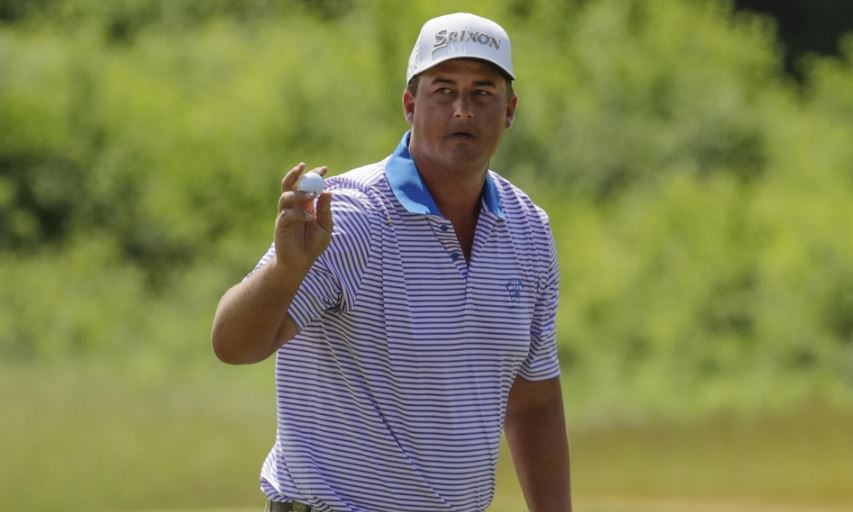Putnam Latest Example Of Not Giving Up On U.S. Open
- Details
- Category: Inside Golf
- Published: 2018-06-07

Michael Putnam Reacting After Making A Putt On The Third Hole During The First Round Of The 2017 U.S. Open. (AP Photo/Charlie Riedel, File)
COLUMBUS, Ohio (Doug Ferguson/AP) — Two players began U.S. Open qualifying by posting a 1-over 73, greatly increasing their odds of seeing Shinnecock Hills only on TV. They were tied for 61st in a sectional qualifier that offered only 14 spots.
Vijay Singh decided to call it a day.
He didn’t show up for the second round, perhaps because he didn’t have his game or the energy. Singh is 55, a three-time major champion and member of the World Golf Hall of Fame. He played his first U.S. Open a month before Jordan Spieth was born. He played his last one in 2012, when Spieth was the low amateur.
Michael Putnam thought about joining Singh.
“Horrible,” he said about his opening round.
Putnam has played enough qualifiers to know that anything worse than 2 under at Brookside usually doesn’t get it done. The 35-year-old from Tacoma, Washington, thought about getting an early start on the road to Chicago for this week’s Web.com Tour event. Instead, he drove 20 minutes to The Lakes course for his second round.
“Honestly, I was just giving it another nine holes and hoping for the best,” Putnam said.
And then the best happened.
He had five birdies at the turn. He made three more over his next four holes. He wound up with a 64, the best score of the day on either golf course, and he had a spot in the U.S. Open next week at Shinnecock Hills on Long Island, New York.
“No one withdraws unless they really don’t think they have a chance,” Putnam said. “That’s why I went over there at 1 over. You can’t shoot over par here and make it. I beat the rule.”
Stories like this unfold every year.
There were 869 players at 11 qualifying sites, and 96 of them never finished. Some didn’t even start. Some stopped after 18 holes. Others gave up midway through the second round when getting to the U.S. Open was a lost cause.
They all have their reasons, especially the tour players. Some don’t want to waste energy on 18 holes when they are between tournaments and have long odds of getting through. Some figure they are only slowing down the course and getting in the way of those who have a chance.
“I’m the king of the nine-hole special,” said Andrew Landry, referring mainly to his days in 18-hole qualifiers for tour events. “It looks bad, but you can’t burn energy. If you’re not in it, why slow other people down?”
He only made it eight holes last year. He was at a Web.com Tour event in North Carolina, his flight was delayed by weather and he wound up connecting in Washington to go to Nashville, Tennessee, driving three hours to Memphis and sleeping two hours before his tee time.
This year, Landry opened with a 74 on the easier Lakes course in Columbus and was gone.
King of the 18-hole special in this case.
Martin Laird had no chance when he walked off after four holes at Brookside. He needed to play the last five holes in 8 under.
“I should thank Martin Laird,” Russell Knox, a fellow Scot, said with a grin. “As soon as he left, I made four birdies.”
Knox was on the ropes, 3 over for his round at Brookside and saving pars instead of making birdies. But over the last five holes, he made four birdies (all but one of them from 15 feet or longer) and saved par out of a bunker with a 6-foot putt. He qualified with two shots to spare.
It was turnaround out of nowhere, something Ramon Bescansa had seen before.
Bescansa, the coach and caddie for Knox, went through U.S. Open qualifying in 2005 at Woodmont Country Club in Maryland. He played that day with Olin Browne, who shot 73 in the opening round and was ready to go home. It already had been a long year for Browne, who had limited PGA Tour status.
“After he finished his first round, he was signing his scorecard and I remember him saying, ‘Hey guys, I might not be playing in the afternoon. I might have to save up my energy,’” Bescansa said. “And then five minutes before the tee time he says, ‘I couldn’t do this to you guys.’ The next thing you know, he shoots 59.”
Browne remembers that afternoon clearly. He said he hit 17 greens in the opening round, shot 1 over and was running hot.
“I thought about hanging it up,” he said. “But how can you quit at something and then tell your kids you can’t quit? I was going to play nine holes. And I shot 30 and had to keep playing. I was a sports psychologist’s dream. It was one of those days I was eternally grateful I didn’t quit.”
Two weeks later, Browne teed off in the penultimate group with Michael Campbell at Pinehurst No. 2, three shots out of the lead. He shot 80 in the final round. Campbell won the U.S. Open. Even so, the spark he found that afternoon in qualifying stayed with him, and Browne won the Deutsche Bank Championship a few months later.
“In retrospect, I owe my success to not hanging it up,” he said.
It doesn’t always work out that way. Putnam and Roberto Castro in the Georgia section were the only players to start with a round over par and make it to the U.S. Open.
When someone suggested to Putnam that he get the “Olin Browne Award,” he smiled. Putnam also was at Woodmont the day Browne shot 59. He made it to his first U.S. Open.



